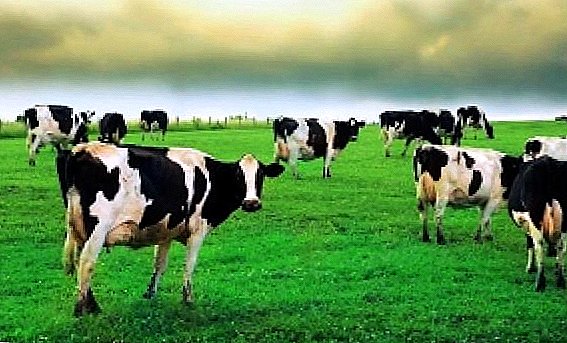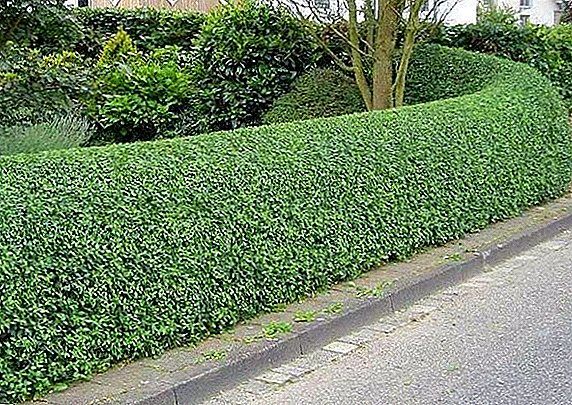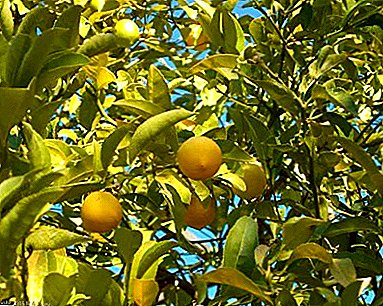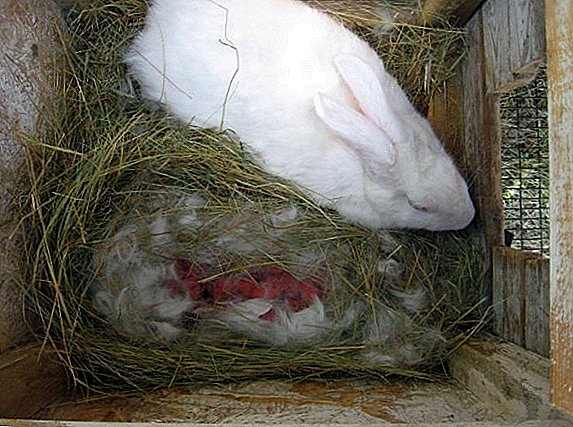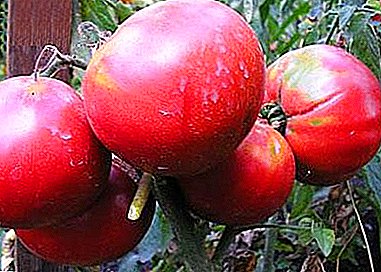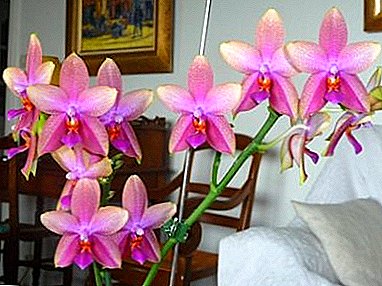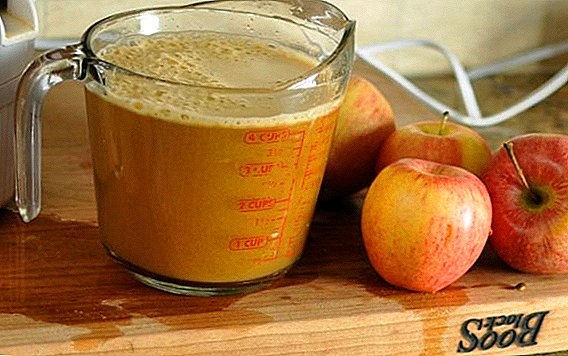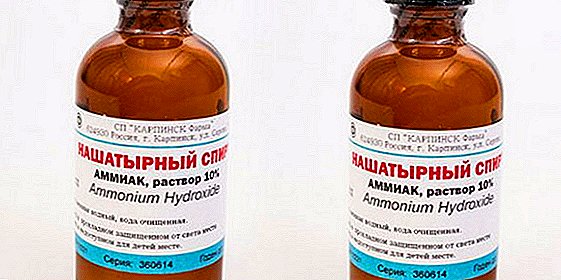 In the first-aid kit you can find products that will fit in the garden. One of these drugs is the well-known liquid ammonia, the “agrarian” properties of which will be described in this article.
In the first-aid kit you can find products that will fit in the garden. One of these drugs is the well-known liquid ammonia, the “agrarian” properties of which will be described in this article.
Ammonia - composition
This drug universal due to its components. By scientific classification, it is called an aqueous solution of ammonium hydroxide (in other words, it is ammonia, or ammonia tincture).
Water acts as an auxiliary element. Colorless liquid is used, first of all, in medicine, but also suitable for domestic needs.  It is a nitrogenous compound, because of which it can be used as a plant food and a means of controlling pests.
It is a nitrogenous compound, because of which it can be used as a plant food and a means of controlling pests.
Due to the characteristic pungent smell, it is difficult to confuse with other means from a home medicine cabinet. Available in the form of a 10% solution, poured into bottles (10, 40, 100 ml). There are also 1 ml ampoules.
Important! "Chemistry" is not inferior to ammonia, but when using it, you need to accurately calculate the dosage.Having such a composition and an affordable price, ammonia is often used in summer cottages.
Useful properties of ammonia solution in the fight against aphids
Experienced gardeners know that pests do not tolerate the sharp smell of this tool. It is successfully used against onion flies and medvedka, wireworms and ants, but the main "client" is aphid.  The nitrogen contained in the solution is well tolerated by the plants themselves, whereas the pests do not tolerate it. Periodic foliar feeding stimulates growth and is a preventive measure in the fight against pests.
The nitrogen contained in the solution is well tolerated by the plants themselves, whereas the pests do not tolerate it. Periodic foliar feeding stimulates growth and is a preventive measure in the fight against pests.
Before describing how ammonia “works” against aphids, consider its effect on garden crops. Such a fertilizer does not accumulate by plants, and it will not work to “hammer” a bush with ammonia.
In the fight against pests, the drugs Akofit, Kinmiks, Bitoxibacillin, Calypso, Aktara, Fitoverm, Inta-vir, Alatar will help you.Chemists know that ammonia - This is the so-called intermediate product in the nitrogen cycle, and it passes to ammonium in air. For us it is important, because using alcohol in the garden is much more efficient (and cheaper) than "organic".
Did you know? For more successful pest control, ladybirds can be added to the infected area. This is one of the most dangerous enemies of aphids.As a result - on a not particularly used site (the same dacha) top dressing to some extent replace the recultivation and help get rid of pests.
For protection against aphids, ammonia is used because of its toxicity and pungent odor.  Even insensitive to human dose is critical for insects. This also applies to wasps, ants, bears and other uninvited guests in the garden. All of them do not tolerate the action of alkalis (and ammonia is just one of them).
Even insensitive to human dose is critical for insects. This also applies to wasps, ants, bears and other uninvited guests in the garden. All of them do not tolerate the action of alkalis (and ammonia is just one of them).
How to get rid of aphids using ammonia, instructions for processing plants
Everyone can prepare a protective compound. For this you need:
- Pre-rub the soap (100 - 200 g). Any, the main thing that without fragrance will approach. Economic also fit.
- The resulting crumb is diluted with a liter of heated distilled water, after which this solution is poured in a thin stream into a bucket of ordinary water.
- We are waiting for the flakes to settle and bubbles will appear, and pour out the leftovers.
- Add a vial of 25% ammonia (at the rate of 50 ml / 10 l of water). The dosage can be changed depending on the container, keeping the proportion.
Important! To get rid of other insects, the solution is made in different, weaker proportions. For example, 1 ml / 5 l of water is the dose for onion flies.
When the compound is ready, the control of pests with liquid ammonia begins immediately - it is impossible to leave the container for a long time. Soap particles "grab" the solution to the leaves and shoots, so the insects will not leave.  For processing plants need a watering can with a "large" nozzle. Due to the volatility of the ammonia base, the trickle should come with splashes.
For processing plants need a watering can with a "large" nozzle. Due to the volatility of the ammonia base, the trickle should come with splashes.
Small nozzle just spray active substance that does not have time to get on the leaves. When using a sprayer the same scheme - put a large tip ("fog" mode is undesirable).
Such processing can be carried out at different times: after dawn (in case of cloudy weather) or after watering, at sunset of a sunny day.
For a small section of the standard frequency of such work - once a season. For densely inhabited, impressive in size problem, it may be necessary to re-spraying (with an interval of two weeks).
Did you know? Mosquitoes also do not tolerate "liquid" smell.Most plants equally "perceive" such a solution. Tomatoes, peppers, cucumbers perfectly tolerate this procedure.
Some varieties of garlic and onions may eventually signal a nitrogen excess (rarely, but sometimes): the shoots start to darken a little and become glossy. Particularly sensitive to "overeating" strawberries - regularly inspect the leaves. The treatment of currant with liquid ammonia differs both in formulation (instead of soap, add a few pinches of laundry detergent) and in terms (repeated “filling” in the presence of pests is obligatory).
As you can see, alcohol is used on different stages of growth - From the seedling phase to the protection of adult bushes and flowers. The above-mentioned “overeating” with nitrogen is not to be feared, this process is manifested only on greasy soil.
Another nuance associated with the effect of alcohol on plants is that it absolutely does not pass into the tissue layer.
Important! To heighten the effect, the treated beds are loosened after watering. So the smell of ammonia lasts longer, scaring insects.However, it is imperative to wash the fruit before use. As well as remember some safety rules when spraying.
Is there any harm in ammonia: safety measures when working with the drug and first aid
Remember that ammonia is one of strong poisons. The skin, mucous membrane and respiratory tract are the main "ways" by which it enters the body. Negligence in working with him is fraught with poisoning, requiring long treatment.
For ammonia containing agents, one of which is ammonia, the instruction on the package is obligatory - do not be too lazy to get acquainted with it.
Wear rubber gloves during preparation and spraying. Closed clothing and eye protection are also useful. When working with climbing varieties or on an elevation, a bonnet and respirator are needed.  These precautions will not be superfluous - aggressive couples are able to harm even different coatings, not to mention the internal organs of a person.
These precautions will not be superfluous - aggressive couples are able to harm even different coatings, not to mention the internal organs of a person.
Treatment with ammonia is also used for greenhouse and indoor plants. Here is the first thing - this is ventilation. In the greenhouses during the warmer months they open frames and doors to disperse the settled air.
In the case of domestic plants, spraying is carried out on the veranda or balcony. At the same time you need to be on the windward side.
Did you know? 10% ammonia solution is used for alcohol poisoning.In a hurry or inadvertently, the drug may get on the skin or in the respiratory tract. In the first case, the affected area is thoroughly washed with water.
 If liquid ammonia gets into the mouth - the same actions, some after rinsing, rinse the lips and mouth with warm milk. In small quantities (most cases) and this costs. For more serious symptoms (vomiting, shock), wait for the doctors.
If liquid ammonia gets into the mouth - the same actions, some after rinsing, rinse the lips and mouth with warm milk. In small quantities (most cases) and this costs. For more serious symptoms (vomiting, shock), wait for the doctors.You can protect plants only by protecting yourself from aggressive "manifestations" of the drug.
Considering the usefulness of such alcohol gardeners, we were convinced of its nutritional and protective properties. Now our readers know how to successfully use ammonia to protect against pests.


